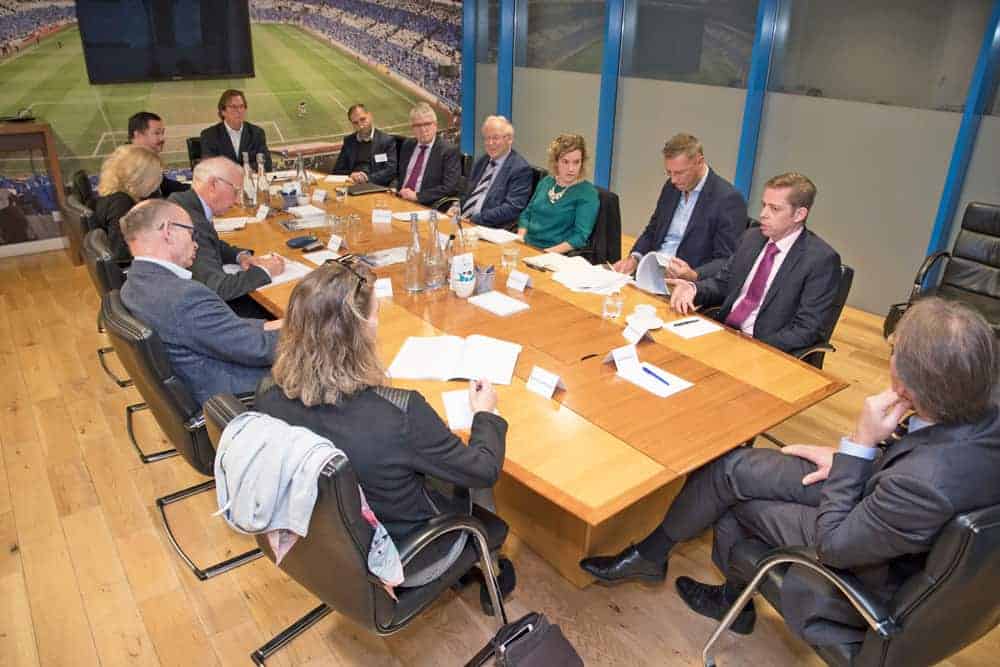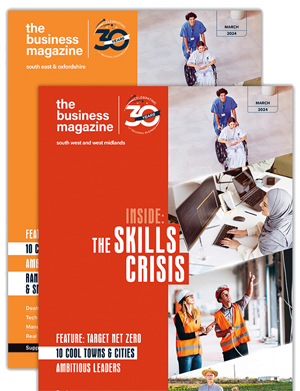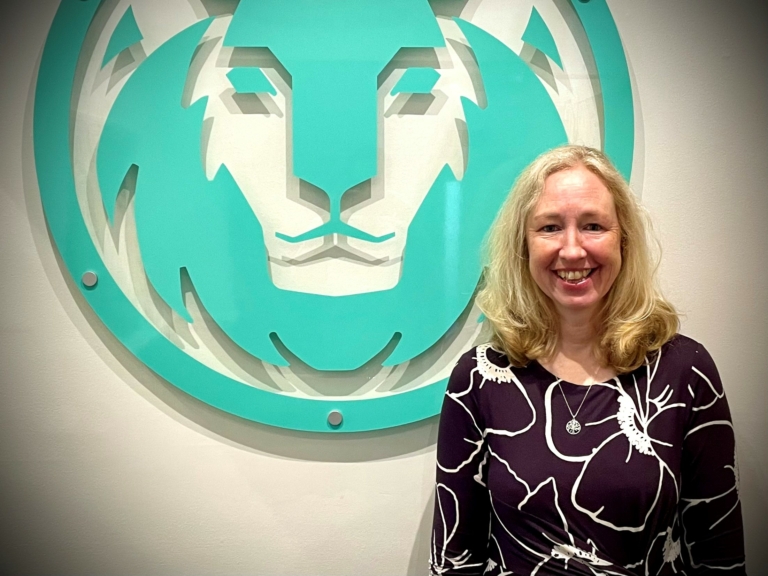The TVBMA Roundtable: Some wise words from successful businesses

The Business Magazine and the sponsors of the TVBMA – NatWest, Pitmans, James Cowper Kreston, Hays, Grundon Waste Management, Deloitte. Redwood Technologies – invited several 2014 winners and finalists to gather at the Madejski Stadium, Reading to share some wise words from successful businesses. ’Gain, Maintain, Retain’ will be the mantra of many Thames Valley companies as the battle for talent – to build teams fit for corporate growth – heats up in 2015.
What will help winners sleep soundly in 2015?
David Murray asked the Roundtable members what the big themes of 2015 might be, and what might keep them awake at night. He suggested 2014 had been a year focused on business capital, and this year it might be human capital.
Chris Sykes of Volume (2014 Best Use of Technology finalist) was first to highlight the difficulties of gaining, maintaining and retaining a suitably skilled workforce. With 70% of clients being outside the UK, predominantly in west coastal USA, Volume’s target was “. . . quality people who really shine through when dealing with large corporate clients in different time-zones.
“Everybody here probably has the same challenge of finding and retaining good people. We are competing with the big tech companies locally that obviously have good benefit packages, and also with the London talent pool with its attractive bright lights for young millennials.”
Sean Taylor of Redwood Technologies (2014 TVBMA category sponsor) concurred, speaking of the business investors’ dilemma. “The scarce resource isn’t capital at the moment – it’s cheap to borrow money. The scare resource is human capital. We are really struggling to get good STEM people on board, and it’s not the money. When I was 21, I wasn’t earning the equivalent salary that is on offer today.
“People today want the challenge, they want to travel perhaps and London does have a strong pull. Getting good quality people and a build-up of workforce skills is really important for us, and indeed the local and national economy.”
Mehran Yadegari of the recruitment specialist Hays provided his well-informed view: “It is all about employee engagement. One part is attracting the right people, but the even bigger part is holding on to great people. If you have great people as part of the fabric of your business you can cope with people coming aboard and then moving on, but you need that core, that spine of quality within your business.”
The fresh challenge of Generation Y
Yadegari also highlighted the change in mindset of potential Generation Y recruits, the millennial age-group who have only ever known a digital world, and as adults tend to be detached from traditional business structures, while closely networked with friends. “This newer generation sees things differently. When we all started working, money was a factor and we viewed employment over a longer-term phase.” For them a long employment phase is 2-3 years within an organisation, before they make a transition to their next life-phase, their next development as a multi-skilled person.
Employee engagement will help retain such people, but “companies will have to put a lot of work into that.”
Marlow-based Thomas International (2014 Management Team Award finalist) had taken on several Generation Y recruits and Simon Pasco confirmed that ”. . . they are different. They’ve been educated and brought up differently, have different demands, 2-3 years is a long time to them, and yet we also have people who have been with us for over 25 years. How do you marry them together, keep your company culture as you are growing and the world is changing? That is a challenge that has to be worked on.”
Christopher Avery of TVBMA sponsor Pitmans had also noticed the millennial Generation Y difference: “When I was in my 20s I wanted security and a future career game-plan, but they are amazingly confident, willing to change, broaden their career horizons and travel, assuming that they will have a job to come back to.”
Overall, this presented different dynamics for firms to tackle, with retention frameworks, including individually challenging but interesting work for millennials, being a key focus.
Yadegari said companies had to accept that there was a shortage of quality skilled recruits. “Most of us hire based on potential, and this is where recruitment companies like ours come into play. Our job is to get to know the client company, its culture and its needs, well enough to be able to bring the right candidates with potential who will fit in and become part of that business. Unfortunately, that perfect solution does not always exist.”
Is Generation Y changing the way we work?
Murray suggested that Generation Y did not react well to the traditional hierarchical business model of performance-based salaries and ladder promotion, preferring team-working collaborative solution-finding, and social interaction – a different way of working.
Simon Miles of ‘Big Four’ firm Deloitte (2014 TVBMA sponsor): “We are fortunate in being a large international business. We can easily move people around our company, on short or long-term assignments, which suits that Generation Y mentality. We probably did not make enough of that advantage in the past, but we do now.”
David Griffiths of FISCAL Technologies (2014 SME of the Year Award) said older experienced talent shouldn’t be overlooked – 60% of the FISCAL staff are over 30, yet the company, a hi-tech company founded in 2002, pro-actively recruited to all ages. “People over 40 or 50 are incredibly hard-working and put a lot of energy and ideas into the business, perhaps because they feel they have to prove more.”
Workplace culture, recruitment and retention
Alan Poole of TVBMA sponsor James Cowper Kreston felt young talent was still attracted by “… the familiar blue-chip logos on massive office blocks,” and while the Thames Valley was a great location to bring up a family, many would still go off to try other places, before returning in their 30s. “We have a very different culture to the bright lights and stock-broker mentality found in London.
David Brookes admitted that even BDO (2014 TVBMA Best Company to Work For winner) suffered from trained talent being poached and tempted by the lure of industry roles, or even positions within other BDO offices. To counteract this, the firm uses its recruitment process as a base of questioning around its established company values. “We are quite picky about ensuring we get the right people to match our values.” Equally, performance appraisals are conducted on this basis. Even so, additional graduate trainees are often taken on to support more local talent and offset ‘poaching’.
Andrew Thomson of HMT (Best Company to Work For 2014 finalist) identified the graduate level, qualified professional with 2-3 years experience as the most difficult recruit to attract and retain. Ironically, “. . . we are often embarrassed by the number and excellent quality of recruits for more junior roles”.
Anthony Foxlee-Brown, said the challenge for Grundon Waste Management (TVBMA sponsor Green Progress), a third generation family-run company with 86 years' heritage, was keeping the company’s family values and culture among its 750-plus ‘extended family’ staff as it moved towards a more corporate way of working. With one director having been with the company for 49 years, Foxlee-Brown noted the Grundon in-joke that: ”If you stay for six months, you are here for life,” – such is the welcoming culture. With more new staff joining, the challenge was to maintain that friendly mood of long-term service.
Avery said his law firm had successfully integrated its culture following the acquisition of Southampton-based Lamport Bassitt, but mentioned that internal training programmes had assisted Pitmans in some measure in attracting and retaining staff. During the downturn many firms had shelved or reduced their training programmes. Pitmans had not, and the result was greater loyalty among its workforce. However, staffing in London was now a particular concern, with firms without training programmes “head-hunting because they are desperate for young talent”.
Is it money or culture that’s important?
Pasco pointed out that money was not always the employment driver. “Cultural fit is a big part of employee engagement, and another is recognition, which to me is part of the employee’s reward package.”
He posed a key question: “If you took money off the table, would your employee be sitting there on a Sunday night not wanting to come in on a Monday, or getting to Friday and looking forward to returning after the weekend?”
Grundon has a good HR team, said Foxlee-Brown, doing impressive employee engagement work. “Our surveys have shown that it isn’t salaries that drive our people. They want time with their families, work-life balance, recognition from the top or their colleagues rather than remuneration. We put in place the processes to make that happen.”
A recent management conference focussing on innovation had resulted in employees suggesting company improvements, which Grundon then committed to invest a significant amount of money in, – the true value being that “. . . our people feel good knowing that they have added value to the company and their input has been recognised”.
Sykes revealed a study detail that he had read in The Wall Street Journal: “Apparently, 93% of employees who stay after an employer’s counter-offer, leave within 18 months.”
Pasco: “It actually shows they’ve moved into a mindset where they are prepared to accept and explore different things.”
Poole: “If somebody is going, money may well be a factor and you can counter-offer, but it’s not usually the key reason. You can try to convince people to stay by saying you will change, but they know you can’t really change things quickly or enough for them to be satisfied.”
Griffiths: “Isn’t there also business research that says most people leave because of their manager or a member of their team?”
Creating a culture that works
“Apart from all the general challenges of my business, the thing that keeps me awake is how to create a business that people want to work for,” said Bryn Aldridge of Drivenlower (2014 TVBMA Best Use of Technology finalist).
“People spend an awful lot of their waking days at work, and need to have a great time there, feel satisfied and personally recognised. That aspect has to come from the top. You can’t create an embedded culture if the people at the top don’t live that culture.”
Ian Morrin of Clarify, a firm of 40 staff, agreed, but pointed out that culture and employee engagement also had to run throughout all layers of the business, to enable it to develop and upscale. “It becomes critical that the next levels down, the future leader layers still embody the core beliefs and attitudes.” If they don’t, it starts to show in company performance and staff churn, he suggested.
Griffiths: “You have to build foundations and company values for a culture, but it does all come from the top.” The four directors had drawn up 20 ‘company values’ and asked the staff to decide the key ones. They had selected innovation, making a difference, agility, partnerships.
“We now live by those. In fact we have an acronym: ‘I’m AP!’ We are all now Fiscalites, and there are lots of little things we can do to build that Fiscalite culture.
“Culture is key, but trying to choose the right people to come into your organisation is the biggest dilemma.”
Murray pointed out that truly embedded company culture is what happens when the directors are not around.
Have you got a people officer?
Employee engagement was something Volume invested in heavily, said Sykes, and since appointing a chief people officer to concentrate on that “our attrition rate has been much better, we are more attractive as an employer brand, and it is reflected in our business performance”.
FISCAL Technologies, with fewer than 50 staff, employed a people and culture manager nine months ago, Griffiths revealed. “She’s incredible. She takes a lot of what the directors are doing and translates that in a culture-enhancing way.”
Pasco of psychometric assessment specialist Thomas International agreed: “You can’t under-estimate the value of people officers. We work with them on a day-to-day basis and they can make the difference between whether staff stay or go.”
Morrin explained that Clarify (2014 TVBMA SME of the Year finalist) does not have a ‘head of people’ but it has recently appointed a head of learning and development who will be responsible for people and culture.
Do you actually know what your culture is?
Defining a company’s actual culture was hugely important, said Yadegari: “If it’s not defined in the right way, you can end up taking on the wrong people, which is where problems can start.”
“It’s a retention issue too,” added HMT’s Thomson. “If people don’t get your culture they won’t stay, no matter what you pay them.”
Poole stressed that how culture is defined and implemented is important because the company will recruit and retain to it. “I see many businesses where the owners think the culture is X and it is actually Y. You don’t want to be recruiting to a culture that doesn’t actually exist.”
He also noted that young fast-growing companies often had difficulty in controlling corporate culture. “You can try to shape it, but it will be what it will be. There will come a time, however, later as a larger business, when you have to define and document your culture.”
Retention was important, said Yadegari, but a certain level of churn is not a bad thing. “You have to have ‘glue’ – a range of good individuals who will stay with the company – but then understand and accept that Generation Y may bring fresh ideas, and move on.”
Boosting the local talent pot
Robin Barnes of TVBMA sponsor NatWest is also a private-sector representative of the Thames Valley Berkshire Local Enterprise Partnership: “The LEP is aware of these employment issues and is trying to focus attention on growing the local pot of potential talent . London may be a draw, but if we could just get Generation Y, which likes moving
around, to believe in moving around between all of our businesses locally, while attracting talent from outside, that would be extremely powerful.” He suggested the Thames Valley technology sector had the ability and the best chance of driving that self-help scenario.
Taylor welcomed the LEP assistance, but pointed out that local infrastructure mattered too. ‘When I was in my 20s, living in London, I liked to step out with my pals and go to a cool bar. We are based in Bracknell and we have waited for a much-wanted regeneration for 20 years. The town centre is currently a pile of rubble. It’s really poor, so it doesn’t matter what we do in terms of cultural values and reward, people will still want to go out for that nice meal or a drink and they will probably go somewhere else.”
The Thames Valley had been “left napping” in its local infrastructure development, he stated. “It’s been too easy – close to Heathrow, London, the M4, M3 corridors, with many European headquarter offices now established – and there hasn’t been the investment in the infrastructure and fun environment of the region.”
Thomson and Sykes both highlighted that young people are not getting on the local property ladder as early as previous generations. Sykes mentioned that 80% of his staff are under 30, and Volume, as an aid to employment attraction and retention, did support staff attempts to get onto the property ladder. “You are millennial until you get a mortgage, and then priorities change.”
Managing the pressures of company growth
Sykes revealed that managing the risks of company growth were a headache at times. Being self-funded, mainly through bank-supported invoice financing, there was a need to keep cashflow healthy, yet Volume was now looking to set up in the US to support client activities. “We are in growth mode, but there is massive risk attached to that. It is going to be a big commitment for us to make that investment but it is crucial for our business. Our clients want to meet us over a coffee not over an email. It’s that risk v reward question.”
Griffiths at FISCAL, now with a growing US operation based in North Carolina, had a similar experience: “We are three years into the US and I can now see the light at the end of the tunnel, but I used to be out there every month trying to drive the business.”
Finding suitable recruits in the US can be even more difficult, he warned, because US work culture was different and even varied between states.
Self-funded FISCAL has grown annually 50-60% for the past five years, and with revenue approaching £4 million, has questions to answer: Do we really need to grow at that rate? Should we be acquiring or partnering? Should we seek additional funding?
Taylor had asked the same questions at Redwood Technologies. “Do we keep going, keep growing as we are, taking the cautious longer-term view similar to the German Mittelstadt model. Or will we miss our window of opportunity? Or do we join the ‘dark side’ of private investment funding? It can be very tempting to consider gathering up a stack of cash, or to sell your business and gain some tax relief, and to make the personal pressures and risks of growth go away.”
Morrin said Clarify was also at that US growth stage decision. “We recognise that we can carry on doing what we are doing here successfully, but many of the organisations we work with are headquarterd in the US so it makes sense for Clarify to have a base there. However the circumstances and environment need to be right for us as a business before we make this investment.”
Griffiths warned that the private equity funding route can fundamentally change the culture of a business.
Thomson pointed out that PE funding can also bring benefits, such as professionalising the business and taking the onus and pressure off an owner-manager.
Taylor noted that the PE funding decision was not always a monetary one. “Either you are going to cede control and de-risk your personal position, or you are going to maintain control. If an investment deal doesn’t feel right, I suggest you walk away.”
Aldridge successfully started Drivenlower with director and angel investment. “But now we need the people and capacity to keep up with the opportunity. We know we should be expanding on the sales and marketing side, but can we keep up with the scale of growth that might bring? Getting funding for that growth depends for us upon getting the right terms for our business. I really enjoy what I do every day at Drivenlower, and part of my fear about funding is not only a different culture, but am I still going to enjoy working at the business?”
Exit or succession management?
“Is there an obsession about exiting from a company?” queried Murray.
Poole: “It is one extreme or the other. A lot of business owners are obsessed with a blinkered run to an exit in a certain time, but others have not considered it. Not enough are flexible, thinking in broad five to10 years terms about it.”
Griffiths: “Doesn’t it become divisive when you set up a business with the exit in mind? I understand about structuring the business correctly and getting a supportive management team but you can lose your focus on growing the business properly if it’s centred around an exit.”
Thomson: “It shouldn’t be called an exit. It’s all about viewing it as succession management. If you do that, is it then about cashing up, stepping back, or about making sure the business survives you?”
Taylor felt business owners in different sectors had to be careful about fixed-term exits. The future is unknown. “Companies can grow very quickly and die even faster,” he said exampling Blackberry’s and Nokia’s positions in the mobile phone market. His company Redwood was set up with a 3-5 year exit strategy… 23 years ago.
Thomson: “The strategy that takes you to an exit shouldn’t be any different to that which builds and grows a good business. If you get that right the exit will follow.”
Griffiths disagreed: “If you focus on exit, you change your mentality.”
Barnes: “Run the company the best way you can for the long term but leave the option available should someone walk in with a fantastic deal. The smart business owner always has that option. So keep open-minded. But running for the exit is wrong, owners then do the short-term things and switch off their people, etc…”
Taylor revealed that Redwood had worked on a 3-5 year exit strategy because that was considered the norm for IT companies at the time. Two directors have now retired, but “… the good thing was that they had a very clear view of how they could step off without affecting the business, which is what happened.”
Sykes: “That’s good succession management isn’t it?” He exampled other business owners he had seen who worked on a strict three-year-and-out strategy and for whom “those three tough years had been the unhappiest of their lives.”
Thomson: “If you are tied in to three years and the business needs you that much, then there is something fundamentally wrong.”
An MBO can be a fairly common exit route said Brookes, and if key staff know that is possibly on the horizon, and they can be allowed to buy shares or acquire share options in the business, such awareness can be useful in retaining key and valued employees.
Morrin reiterated that the objective of growing the business should involve a good management team below board level, in order to establish a solid foundation for the business and ensure consistency whatever management changes occurred within the organisation.
Griffiths said FISCAL actually had that: a B-Team (the Board) and an A-Team of nine managers who run the business operations. “That’s just good fundamental business practice. Getting from 50 to 100 staff has to be done through our operational team, for example.”
Poole suggested an exit should not be the motivator for growth. Building the business in the right way should lead to a potential exit being the outcome of that good planning. “Almost by accident you will make the business exit-ready by doing the right things.
”Think of making the business ready so that you can go off for a year on a yacht.”
What changes are coming down the track?
“Big Data” said Yadegari. “Utilising data in the most efficient manner will be a big challenge.” With businesses now able to gather masses of data, there was a need to understand and use that data to “. . . provide service that hits the mark for people who are trying to engage with businesses”.
Sykes suggested the technological advance of contemplative computers, which will in future interact more naturally with the human brain, would underpin the value of Big Data by providing more relevant and useful answers. This new computing technology might even change the face of the sector with some “global behemoths becoming a shadow of their former selves”. He felt “. . . there has never been a better opportunity for SMEs to grow than over the next 3-5 years”.
Griffiths and Sykes both highlighted the dilemma of growth – the desire to retain the agile SME culture of creative and motivational drive provided by a team of around 50 people, while trying to meet increasing client demand and commercial opportunities.
Avery said Pitmans had overcome that to a large degree by embracing new technology and investing in the upgrading of its internal systems, enabling greater productivity for its clients. He also suggested there was ‘technological tardiness’ within parts of the professional services sector, and firms would lag behind at their peril or face potential loss of clients and sector consolidation.
Pasco highlighted technological growth and change too. Generation Y was one group but what about future generations? Already those children live in a different world, with digital mindsets. He conjectured whether psychometric assessments by Thomas International would have to go down a gamification route in future? On new hand-held devices?
Taylor mentioned the growing involvement of Asian interests within the technology sector. Their technical knowledge and quality had improved in recent years and accordingly their global market share and influence. ‘Made in China’ hi tech was now a particular force in developed countries, Taylor said. “If you look at Britain and the US as trading nations, and then what China is doing – getting out there, investing, putting the hard work in, their advanced educational standards, and they are commercially keen.” Looking positively, Taylor ventured that the threat “. . . should keep us on our toes.”
Griffiths: “Are the Chinese that entrepreneurial? I think India is a bigger threat.”
Taylor suggested India was “mired in bureaucracy” which limited that threat. “We do still have an edge but things can change. Look at the transformation of the Japanese car industry from 40 years ago.”
Murray mentioned the European market and the potential business risk of the UK referendum on EU membership?
Poole felt uncertainty was the major business concern, and the long period until the outcome was known.
Barnes noted that there was evidence of some businesses and foreign investors already ‘”dabbing the brakes” due to EU uncertainty.
There was general Roundtable agreement that the UK business mindset favoured staying in the EU.
Pasco and Taylor both highlighted the differences between different national markets and cultures within the EU, particularly with their varying economic stabilities. While English was a natural language of business, investing and staffing for those individual EU markets, perhaps with skilled native speakers, had to be carefully considered.
And soon the Roundtable discussion had come full circle as Barnes highlighted the need to recruit suitable talent: “…able people, friendly people with great personalities. That’s what I need for my business, and what I will continue to need most”.
Participants:
Bryn Aldridge: Chief technical officer, Drivenlower vehicle telematics
Christopher Avery: Managing partner, Pitmans LLP
Robin Barnes: Regional director, Corporate & Commercial Banking Thames Valley, Nat West
David Brookes: Partner BDO LLP
Anthony Foxlee-Brown: Marketing communications manager, Grundon Waste Management
David Griffiths: CEO, FISCAL Technologies
Simon Miles: Senior business development manager, Deloitte
Ian Morrin: Director, Clarify, Strategic B2B Business Development
Simon Pasco: London region sales director, Thomas International
Alan Poole: Partner, James Cowper Kreston LLP
Chris Sykes: CEO Volume, digital content provider
Sean Taylor: MD, Redwood Technologies
Andrew Thomson: Partner – HMT LLP
Mehran Yadegari: Regional director, Hays
David Murray: Managing editor and publisher of The Business Magazine, chaired the discussion















